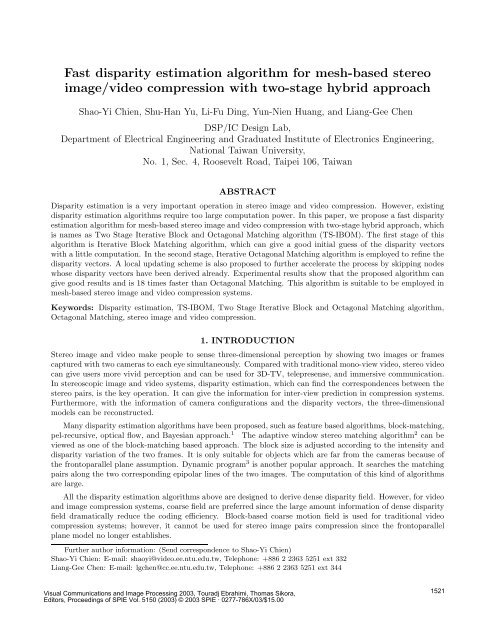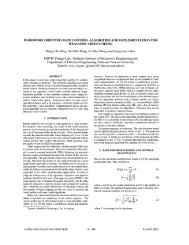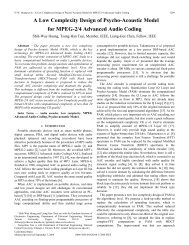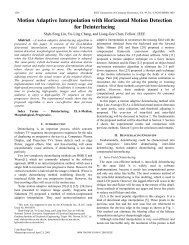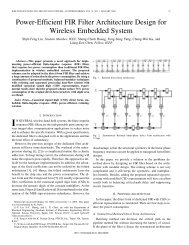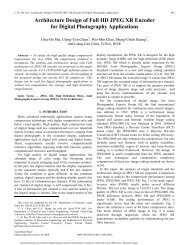Fast disparity estimation algorithm for mesh-based stereo image ...
Fast disparity estimation algorithm for mesh-based stereo image ...
Fast disparity estimation algorithm for mesh-based stereo image ...
Create successful ePaper yourself
Turn your PDF publications into a flip-book with our unique Google optimized e-Paper software.
<strong>Fast</strong> <strong>disparity</strong> <strong>estimation</strong> <strong>algorithm</strong> <strong>for</strong> <strong>mesh</strong>-<strong>based</strong> <strong>stereo</strong><br />
<strong>image</strong>/video compression with two-stage hybrid approach<br />
Shao-Yi Chien, Shu-Han Yu, Li-Fu Ding, Yun-Nien Huang, and Liang-Gee Chen<br />
DSP/IC Design Lab,<br />
Department of Electrical Engineering and Graduated Institute of Electronics Engineering,<br />
NationalTaiwan University,<br />
No. 1, Sec. 4, Roosevelt Road, Taipei 106, Taiwan<br />
ABSTRACT<br />
Disparity <strong>estimation</strong> is a very important operation in <strong>stereo</strong> <strong>image</strong> and video compression. However, existing<br />
<strong>disparity</strong> <strong>estimation</strong> <strong>algorithm</strong>s require too large computation power. In this paper, we propose a fast <strong>disparity</strong><br />
<strong>estimation</strong> <strong>algorithm</strong> <strong>for</strong> <strong>mesh</strong>-<strong>based</strong> <strong>stereo</strong> <strong>image</strong> and video compression with two-stage hybrid approach, which<br />
is names as Two Stage Iterative Block and Octagonal Matching <strong>algorithm</strong> (TS-IBOM). The first stage of this<br />
<strong>algorithm</strong> is Iterative Block Matching <strong>algorithm</strong>, which can give a good initial guess of the <strong>disparity</strong> vectors<br />
with a little computation. In the second stage, Iterative Octagonal Matching <strong>algorithm</strong> is employed to refine the<br />
<strong>disparity</strong> vectors. A local updating scheme is also proposed to further accelerate the process by skipping nodes<br />
whose <strong>disparity</strong> vectors have been derived already. Experimental results show that the proposed <strong>algorithm</strong> can<br />
give good results and is 18 times faster than Octagonal Matching. This <strong>algorithm</strong> is suitable to be employed in<br />
<strong>mesh</strong>-<strong>based</strong> <strong>stereo</strong> <strong>image</strong> and video compression systems.<br />
Keywords: Disparity <strong>estimation</strong>, TS-IBOM, Two Stage Iterative Block and Octagonal Matching <strong>algorithm</strong>,<br />
Octagonal Matching, <strong>stereo</strong> <strong>image</strong> and video compression.<br />
1. INTRODUCTION<br />
Stereo <strong>image</strong> and video make people to sense three-dimensional perception by showing two <strong>image</strong>s or frames<br />
captured with two cameras to each eye simultaneously. Compared with traditional mono-view video, <strong>stereo</strong> video<br />
can give users more vivid perception and can be used <strong>for</strong> 3D-TV, telepresense, and immersive communication.<br />
In <strong>stereo</strong>scopic <strong>image</strong> and video systems, <strong>disparity</strong> <strong>estimation</strong>, which can find the correspondences between the<br />
<strong>stereo</strong> pairs, is the key operation. It can give the in<strong>for</strong>mation <strong>for</strong> inter-view prediction in compression systems.<br />
Furthermore, with the in<strong>for</strong>mation of camera configurations and the <strong>disparity</strong> vectors, the three-dimensional<br />
models can be reconstructed.<br />
Many <strong>disparity</strong> <strong>estimation</strong> <strong>algorithm</strong>s have been proposed, such as feature <strong>based</strong> <strong>algorithm</strong>s, block-matching,<br />
pel-recursive, optical flow, and Bayesian approach. 1 The adaptive window <strong>stereo</strong> matching <strong>algorithm</strong> 2 can be<br />
viewed as one of the block-matching <strong>based</strong> approach. The block size is adjusted according to the intensity and<br />
<strong>disparity</strong> variation of the two frames. It is only suitable <strong>for</strong> objects which are far from the cameras because of<br />
the frontoparallel plane assumption. Dynamic program 3 is another popular approach. It searches the matching<br />
pairs along the two corresponding epipolar lines of the two <strong>image</strong>s. The computation of this kind of <strong>algorithm</strong>s<br />
are large.<br />
All the <strong>disparity</strong> <strong>estimation</strong> <strong>algorithm</strong>s above are designed to derive dense <strong>disparity</strong> field. However, <strong>for</strong> video<br />
and <strong>image</strong> compression systems, coarse field are preferred since the large amount in<strong>for</strong>mation of dense <strong>disparity</strong><br />
field dramatically reduce the coding efficiency. Block-<strong>based</strong> coarse motion field is used <strong>for</strong> traditional video<br />
compression systems; however, it cannot be used <strong>for</strong> <strong>stereo</strong> <strong>image</strong> pairs compression since the frontoparallel<br />
plane model no longer establishes.<br />
Further author in<strong>for</strong>mation: (Send correspondence to Shao-Yi Chien)<br />
Shao-Yi Chien: E-mail: shaoyi@video.ee.ntu.edu.tw, Telephone: +886 2 2363 5251 ext 332<br />
Liang-Gee Chen: E-mail: lgchen@cc.ee.ntu.edu.tw, Telephone: +886 2 2363 5251 ext 344<br />
Visual Communications and Image Processing 2003, Touradj Ebrahimi, Thomas Sikora,<br />
Editors, Proceedings of SPIE Vol. 5150 (2003) © 2003 SPIE · 0277-786X/03/$15.00<br />
1521
On the other hand, <strong>mesh</strong>-<strong>based</strong> video coding is a new technique <strong>for</strong> motion <strong>estimation</strong> and compensation. 4<br />
The advantage of <strong>mesh</strong>-<strong>based</strong> processing is that it can always provide better per<strong>for</strong>mance <strong>for</strong> both spatial and<br />
temporal interpolation. There<strong>for</strong>e, it has been found being more effective to be used <strong>for</strong> inter-view prediction<br />
since it can provide a coarse representation of the <strong>disparity</strong> field with adequate models degenerated from threedimensional<br />
<strong>mesh</strong>. 5<br />
For <strong>mesh</strong>-<strong>based</strong> <strong>disparity</strong> <strong>estimation</strong> and compensation, Hexagonal Matching <strong>algorithm</strong> (or Octagonal Matching<br />
<strong>for</strong> rectangular patches) 6 can give near-optimal solutions and is widely used. Although it can provide good<br />
per<strong>for</strong>mance, the computation intensity is enormous. A fast <strong>algorithm</strong> is proposed by Wangs with gradientdescent<br />
technique5 ; however, it is easy to be trapped in local minimum, and the computation intensity is still<br />
too large. Consequently, a fast <strong>algorithm</strong> is required <strong>for</strong> <strong>mesh</strong>-<strong>based</strong> <strong>disparity</strong> <strong>estimation</strong> <strong>for</strong> a <strong>stereo</strong> <strong>image</strong> and<br />
video compression system.<br />
In this paper, we propose a novel fast <strong>disparity</strong> <strong>estimation</strong> <strong>algorithm</strong> with two-stage hybrid approach named<br />
as Two Stage Iterative Block and Octagonal Matching (TS-IBOM) <strong>algorithm</strong>. In the first stage, Iterative Block<br />
Matching <strong>algorithm</strong> can give a good initial value of the <strong>disparity</strong> vector of each node. Next, in the second stage,<br />
Iterative Octagonal Matching <strong>algorithm</strong> is applied to refine the <strong>disparity</strong> vectors. Furthermore, a local updating<br />
scheme is also proposed to further accelerate the process.<br />
This paper is organized as follows. In Section 2, the concepts of <strong>disparity</strong> <strong>estimation</strong> <strong>for</strong> <strong>mesh</strong>-<strong>based</strong> <strong>disparity</strong><br />
compensation are introduced. Then the proposed <strong>algorithm</strong> is described in Section 3, and the experimental<br />
results are shown in Section 4. Finally, Section 5 concludes this paper.<br />
2. DISPARITY ESTIMATION FOR MESH-BASED DISPARITY COMPENSATION<br />
In this section, the concepts and models of <strong>mesh</strong>-<strong>based</strong> <strong>disparity</strong> compensation are first introduced in Section<br />
2.1. Next, in Section 2.2, the constraints of <strong>disparity</strong> vectors are described. The classical <strong>disparity</strong> <strong>estimation</strong><br />
<strong>algorithm</strong>, Octagonal Matching <strong>algorithm</strong>, is then introduced in Section 2.3. It will be an important benchmark<br />
<strong>algorithm</strong> in this paper.<br />
2.1. Mesh-Based Disparity Compensation<br />
The model of <strong>mesh</strong>-<strong>based</strong> <strong>disparity</strong> compensation can be shown as Fig. 1. A physical object can always be<br />
represented with three-dimensional <strong>mesh</strong> models, that is, the surfaces of the object are modeled as several<br />
continuous small patches, where each patch is a small plane. The three-dimensional <strong>mesh</strong> models are projected<br />
to the <strong>image</strong> plane to <strong>for</strong>m two-dimensional <strong>mesh</strong>. When two cameras are considered, there are two <strong>image</strong> planes,<br />
and the <strong>mesh</strong>es projected on the left <strong>image</strong> plane and the right <strong>image</strong> plane are illustrated in Fig. 1. Since each<br />
patch is a small plane, the two coordinates corresponding to the same physical object can be trans<strong>for</strong>med to<br />
each other with perspective or affine trans<strong>for</strong>m. For example, if the projected coordinate of the left eye of the<br />
man is Pl in the left <strong>image</strong> plane and is Pr in the right <strong>image</strong> plane. We can always find an affine trans<strong>for</strong>m W ,<br />
with which Pr = W (Pl) andPl = W −1 (Pr).<br />
There are several assumptions <strong>for</strong> the two-dimensional <strong>mesh</strong> model. First, there is no <strong>disparity</strong> discontinuity,<br />
that is, the surface of the object is continuous. Second, no occlusion occurs. With these two assumptions, the<br />
two-dimensional <strong>mesh</strong> model can provide the same per<strong>for</strong>mance as that of the three-dimensional <strong>mesh</strong> model.<br />
There are two kinds of two-dimensional <strong>mesh</strong>: regular <strong>mesh</strong> and arbitrary <strong>mesh</strong>. 4 With arbitrary <strong>mesh</strong>,<br />
the delicate surface structure can be represented with small patches, and the smooth surface can be represented<br />
with large patches. There<strong>for</strong>e, the per<strong>for</strong>mance of arbitrary <strong>mesh</strong> is better. But it is not suitable to be used<br />
in a compression system since the positions of the nodes should also be transmitted to the decoder, which<br />
introduces large bit-rate overhead. Moreover, the geometry of the <strong>mesh</strong> should be reconstructed with Delaunay<br />
triangulation operation in the decoder, which introduces large computation power overhead. Consequently,<br />
regular <strong>mesh</strong>, where all the surfaces are modeled with rectangular patches in the same size, is more suitable <strong>for</strong><br />
compression systems and is considered in this paper since only few parameters are required to represented the<br />
geometry of the <strong>mesh</strong>.<br />
The concept of <strong>mesh</strong>-<strong>based</strong> <strong>disparity</strong> compensation is shown in Fig. 2, where the one <strong>image</strong> of the <strong>stereo</strong><br />
pair is reconstructed (compensated) with the other <strong>image</strong> by warping the two-dimensional <strong>mesh</strong>. In this paper,<br />
1522 Proc. of SPIE Vol. 5150
Affine Trans<strong>for</strong>m<br />
Left Frame Right Frame<br />
Figure 1. Projection a three-dimensional <strong>mesh</strong> to two-dimensional <strong>mesh</strong>.<br />
W -1 (P)<br />
Left Frame<br />
(Reference Frame)<br />
W<br />
D n<br />
n-w-1 n-w n-w+1<br />
P<br />
n-1 n n+1<br />
n+w-1 n+w<br />
Right Frame<br />
n+w+1<br />
Figure 2. Illustration of <strong>mesh</strong>-<strong>based</strong> <strong>disparity</strong> compensation.<br />
the left frame is used as the reference frame to predict the right frame. Because regular <strong>mesh</strong> is employed here,<br />
the right frame (current frame) is divided into blocks, and nodal nodes are placed at the four corners of these<br />
blocks. The texture of left frame is warped to the right frames according to the positions of the nodal nodes by<br />
use of the following equations:<br />
<strong>for</strong> every pixel P =(x, y) in the right frame,<br />
I ′ r(P) =Il(W −1 (P)), (1)<br />
W −1 (P) = <br />
i∈N(P)<br />
φi(P)Di + P, (2)<br />
where Ir(P) is the right frame, Il(P) is the right frame, I ′ r (P) is the prediction frame <strong>for</strong> the right frame from<br />
the left frame, W (.) is the warping function, φi is the weighting function, Di is the <strong>disparity</strong> vector of node n,<br />
and N(P) is the set of neighboring nodal nodes of the pixel P. For example, N(P) ={n − w, n − w +1,n,n+1}<br />
in Fig. 2, where w is the number of horizontal nodal nodes. Note that bi-linear interpolation technique is applied<br />
here instead of affine trans<strong>for</strong>m because of its better per<strong>for</strong>mance. 5<br />
2.2. Constraints of Disparity Vectors<br />
The <strong>disparity</strong> vectors should meet two kinds of constraints: epipolar constraint and ordering constraint. 7 To<br />
meet the epipolar constraint, the corresponding pixels in a <strong>stereo</strong> pair always lie on the respective epipolar<br />
Proc. of SPIE Vol. 5150 1523
lines. For a parallel camera configuration, namely, the two cameras are set in parallel, the epipolar lines are all<br />
horizontal. Only <strong>disparity</strong> vectors in x-direction should be considered, and the y component of the vectors are<br />
all zero. This property can dramatically simplify the computation; there<strong>for</strong>e, in this paper, we only consider<br />
parallel camera configuration. For <strong>stereo</strong> pairs captured with other camera configurations, the epipolar geometry<br />
should be first derived, and the <strong>image</strong>s can be calibrated to parallel camera configuration. 8<br />
The second constraint is the ordering constraint, which can be expressed as the following equation.<br />
This constraint imply that the <strong>mesh</strong> should not cross to each other.<br />
If Pi < Pj ⇒ W −1 (Pi)
Left Frame<br />
(Reference Frame)<br />
W<br />
D n<br />
n-w-1 n-w n-w+1<br />
n-1 n n+1<br />
n+w-1 n+w<br />
Right Frame<br />
n+w+1<br />
Figure 3. Illustration of Octagonal Matching <strong>algorithm</strong>.<br />
Left Frame<br />
(Reference Frame)<br />
D n<br />
NB'(n)<br />
n+1<br />
Right Frame<br />
Figure 4. Illustration of Iterative Block Matching <strong>algorithm</strong>.<br />
3.1. Stage One: Iterative Block Matching Algorithm.<br />
In the first stage, Iterative Block Matching <strong>algorithm</strong> is proposed. In each iteration, <strong>for</strong> each node n, wefixed<br />
the <strong>disparity</strong> vectors of the other nodes. The <strong>disparity</strong> vector can be found with the following equation:<br />
<br />
Dn =argmin |Ir(P) − Il(P + Dn)|, (7)<br />
Dn<br />
P∈NB ′ (n)<br />
where NB ′ (n) is a block centered at the node n in the right <strong>image</strong>, as shown in Fig. 4, Dn is a <strong>disparity</strong> vector<br />
with x component is Dn and y component is 0, and the candidates of <strong>disparity</strong> vectors are also the same as (6).<br />
The same procedure is repeated iteratively until the <strong>disparity</strong> vectors converge. Since no warping operations are<br />
involved in the procedure, block matching <strong>algorithm</strong> is much faster than Octagonal Matching. On the other hand,<br />
the per<strong>for</strong>mance is better than the traditional block matching <strong>algorithm</strong> because the search range is unlimited<br />
and the ordering constraint can be maintained as well with the iterative approach. There<strong>for</strong>e, the first stage can<br />
derive a good initial guess <strong>for</strong> the <strong>disparity</strong> vectors with a little computation; however, it may be failed in some<br />
portions whose <strong>disparity</strong> vector field are not smooth, such as the boundaries and the noses of the objects, which<br />
is due to the model mismatch between block matching and <strong>stereo</strong> video.<br />
3.2. Stage Two: Iterative Octagonal Matching <strong>algorithm</strong><br />
In the second stage, the Iterative Octagonal Matching <strong>algorithm</strong>, which is similar to the one-step search <strong>algorithm</strong>,<br />
9 is employed to refine the <strong>disparity</strong> vectors. For every node in each iteration,<br />
Dn =argmin<br />
Dn<br />
<br />
|Ir(P) − I ′ r (P)|, (8)<br />
P∈NB(n)<br />
(Dn mod 2m )=0<br />
where m is set to 2 in the first iteration, set to 1 in the second iteration, and set to 0 in the following iterations.<br />
Similarly, the procedure stops after the <strong>disparity</strong> vectors converge. The main concept of this <strong>algorithm</strong> is<br />
Proc. of SPIE Vol. 5150 1525
Figure 5. Nodal nodes whose <strong>disparity</strong> vectors are required to be further refined after five iterations in stage one.<br />
described as follows. The computation of Octagonal Matching <strong>algorithm</strong> in the first several iterations is redundant<br />
since the derived <strong>disparity</strong> vectors are invalid when the <strong>disparity</strong> vectors of the neighbored nodal nodes are<br />
uncertain. Compared with Octagonal Matching, the proposed <strong>algorithm</strong> is a coarse-to-fine approach, where a<br />
coarse results can be found in the first two iterations, and the fine results can be derived in the last several<br />
iterations. The redundant computation of the first several iterations are removed with coarse search strategy.<br />
On the other hand, the accuracy of Octagonal Matching is still maintained with the fine search strategy in the<br />
last several iterations. Consequently, the Iterative Octagonal Matching <strong>algorithm</strong> can per<strong>for</strong>m as well as the<br />
Octagonal Matching <strong>algorithm</strong> with fewer computation power.<br />
3.3. Local Updating and Shape-Adaptive Scheme<br />
In the experiments, we found that after several iterations, most of the <strong>disparity</strong> vectors are derived, and only a<br />
few nodes need to be refined. To further accelerate the process, we also propose a local updating scheme, where<br />
<strong>disparity</strong> <strong>estimation</strong> is only applied on the nodes within regions having large prediction error. For every node in<br />
each iteration, the difference of the <strong>disparity</strong> compensated frame and the right <strong>image</strong> of the four blocks connected<br />
to the current node is evaluated. If the difference is less than a threshold, the current node will not need to<br />
be processed in the next iteration and can be skipped. This scheme can accelerate the process with negligible<br />
quality degradation. An example is shown in Fig. 5. After five iterations in stage one, the nodal nodes which<br />
need to be refined are marked. It shows that only the nodes near the nose and the boundaries are marked. The<br />
<strong>disparity</strong> vectors of these nodes are then further refined with Iterative Octagonal Matching <strong>algorithm</strong>.<br />
On the other hand, the assumptions of <strong>mesh</strong>-<strong>based</strong> <strong>disparity</strong> compensation imply the <strong>disparity</strong> <strong>estimation</strong><br />
<strong>algorithm</strong> should be applied on each video object separately, that is, a video object segmentation <strong>algorithm</strong>10 may be required as a pre-processing. If the video object masks are available, a shape-adaptive scheme can skip<br />
nodal nodes which do not belong to the video object.<br />
4. EXPERIMENTAL RESULTS<br />
The test plat<strong>for</strong>m is a PC with a Pentium-4 1.6 GHz processor. The standard <strong>stereo</strong> test sequence Anne, whose<br />
size is 720x288, is taken as an example in Fig. 6. The block size is 16x16. Figure 6(a) is the left frame, and Fig.<br />
6(b) is the right frame. The target of the proposed <strong>algorithm</strong> is to generate a good prediction frame <strong>for</strong> Fig. 6(b)<br />
only from the in<strong>for</strong>mation of Fig. 6(a). After the first stage, the result is shown in Fig. 6(c). It is obvious that<br />
the <strong>disparity</strong> vectors of the nodes near the boundaries are not correct. After the process of the second stage,<br />
the result is shown in Fig. 6(d), which is very similar to Fig. 6(b). It is shown that with <strong>mesh</strong>-<strong>based</strong> <strong>disparity</strong><br />
compensation and the proposed <strong>disparity</strong> <strong>estimation</strong> <strong>algorithm</strong>, the left frame can give good prediction <strong>for</strong> the<br />
right frame, which is very valuable in a <strong>stereo</strong> coding system. The corresponding two-dimensional <strong>mesh</strong>es are<br />
shown in Fig. 6(e) and Fig. 6(f). Note that the regular <strong>mesh</strong> is employed here, which is shown in Fig. 6(f).<br />
Similar results can be found in Fig. 7, where the other sequence Man sizing in 386x193 is tested. After the<br />
process of the first stage, the compensated frame is shown in Fig. 7(c), where the compensated regions near the<br />
1526 Proc. of SPIE Vol. 5150
(a) (b)<br />
(c) (d)<br />
(e) (f)<br />
Figure 6. (a) Origin left frame of Anne #001. (b) Origin right frame of Anne #001. (c) Warped frame after the first<br />
stage. (d) Warped frame after the second stage. (e) The corresponding <strong>mesh</strong> of the left frame. (f) The regular <strong>mesh</strong> of<br />
the right frame.<br />
nose and the boundaries of the face are not correct. After the second stage, the result is shown in Fig. 7(d). It<br />
is very similar to Fig. 7(b).<br />
The subjective comparison of each iteration of Octagonal Matching, TS-IBOM, and TS-IBOM with local<br />
updating scheme (TS-IBOM+LU) is shown in Fig 8. It shows the <strong>disparity</strong> vectors of the proposed <strong>algorithm</strong>s<br />
converge more quickly than those of Octagonal Matching. The final results of TS-IBOM are very similar to that<br />
of Octagonal Matching with less computation power. There<strong>for</strong>e, it is more effective than Octagonal Matching.<br />
Compared TS-IBOM with TS-IBOM+LU, it shows that the per<strong>for</strong>mance of these two <strong>algorithm</strong>s are similar. It<br />
is proven that the local updating scheme can further accelerate the <strong>disparity</strong> <strong>estimation</strong> process with negligible<br />
quality degradation. The objective comparison is shown in Fig. 9, where only the <strong>for</strong>eground object is considered,<br />
and similar results can be found. Octagonal Matching can achieve 30.51 dBin PSNR with nine iterations, TS-<br />
IBOM can achieve 30.10 dB with seven iterations, and TS-IBOM+LU can achieve 28.65 dB with seven iterations,<br />
too. Note that, although the PSNR is 1.86 dBlower than that of Octagonal Matching, the subjective quality is<br />
almost the same, as shown in Fig. 8.<br />
The PSNR-Runtime chart is shown in Fig. 10. To achieve similar subjective quality, the runtime of Octagonal<br />
Matching, TS-IBOM and TS-IBOM+LU are 45,460 ms, 8,230 ms, and 2,420 ms. It shows that TS-IBOM is<br />
5.52 times faster than octagonal, and TS-IBOM+LU is 18.79 faster. Note that the gradient-descent <strong>based</strong> fast<br />
<strong>algorithm</strong>5 is only twelve times faster. Figure 10 also shows that the proposed two <strong>algorithm</strong>s can achieve high<br />
PSNR with only short runtime, which are more effective than Octagonal Matching.<br />
Proc. of SPIE Vol. 5150 1527
(a) (b)<br />
(c) (d)<br />
Figure 7. (a) Origin left frame of Man #001. (b) Origin right frame of Man #001. (c) Warped frame after the first<br />
stage. (d) Warped frame after the second stage.<br />
5. CONCLUSION<br />
In this paper, we propose a two-stage fast <strong>disparity</strong> <strong>estimation</strong> <strong>algorithm</strong> <strong>for</strong> <strong>mesh</strong>-<strong>based</strong> <strong>image</strong> and video<br />
compression named as TS-IBOM. With Iterative Block Matching <strong>algorithm</strong> and Iterative Octagonal Matching<br />
<strong>algorithm</strong>, the proposed <strong>algorithm</strong> can give good prediction frame with less computation. It can be further<br />
accelerated with local updating scheme, by which 18 times speedup can be achieved compared with Octagonal<br />
Matching.<br />
REFERENCES<br />
1. A. Redert, E. Hendriks, and J. Biemond, “Correspondence <strong>estimation</strong> in <strong>image</strong> pairs,” IEEE Signal Processing<br />
Magazine 16, pp. 29–46, May 1999.<br />
2. T. Kanade and M. Okutomi, “A <strong>stereo</strong> matching <strong>algorithm</strong> with an adaptive window: theory and experiment,”<br />
IEEE Transactions on Pattern Analysis and Machine Intelligence 16, pp. 920–932, Sept. 1994.<br />
3. N. Grammalidis and M. G. Strintzis, “Disparity and occlusion <strong>estimation</strong> in multiocular systems and their<br />
coding <strong>for</strong> the communication of multiview <strong>image</strong> sequences,” IEEE Transactions on Circuits and Systems<br />
<strong>for</strong> Video Technology 8, pp. 328–344, June 1998.<br />
4. A. M. Tekalp, P. V. Beek, C. Toklu, and B. Gunsel, “Two-dimensional <strong>mesh</strong>-<strong>based</strong> visual-object representation<br />
<strong>for</strong> interactive synthetic/natural digital video,” Proceedings of the IEEE 86, pp. 1029–1051, June<br />
1998.<br />
5. R.-S. Wang and Y. Wang, “Multiview video sequence analysis, compression, and virtual viewpoint synthesis,”<br />
IEEE Transactions on Circuits and Systems <strong>for</strong> Video Technology 10, pp. 397–410, Apr. 2000.<br />
6. Y. Nakaya and H. Harashima, “Motion compensation <strong>based</strong> on spatial trans<strong>for</strong>mations,” IEEE Transations<br />
on Circuits and Systems <strong>for</strong> Video Technology 4, pp. 339–356, June 1994.<br />
7. Y. Wang, J. Ostermann, and Y.-Q. Zhang, Video Processing and Communications, Prentice Hall, New<br />
Jersey, 2002.<br />
1528 Proc. of SPIE Vol. 5150
Iteration 1<br />
Iteration 2<br />
Iteration 3<br />
Iteration 4<br />
Iteration 5<br />
Iteration 6<br />
Iteration 7<br />
Iteration 8<br />
Iteration 9<br />
Octagonal Matching TS-IBOM TS-IBOM+LU<br />
Figure 8. Subjective comparison of each iteration of Octagonal Matching, TS-IBOM and TS-IBOM+LU.<br />
Proc. of SPIE Vol. 5150 1529
PSNR(dB)<br />
PSNR(dB)<br />
31<br />
30<br />
29<br />
28<br />
27<br />
26<br />
25<br />
24<br />
23<br />
22<br />
FSOM<br />
TS-IBOM<br />
TS-IBOM+LU<br />
21<br />
0 1 2 3 4 5<br />
Iteration Number<br />
6 7 8 9 10<br />
31<br />
30<br />
29<br />
28<br />
27<br />
26<br />
25<br />
24<br />
23<br />
22<br />
Figure 9. PSNR-Iteration chart.<br />
FSOM<br />
TS-IBOM<br />
TS-IBOM+LU<br />
21<br />
0 5000 10000 15000 20000 25000 30000 35000 40000 45000 50000<br />
Accumulated Runtime (ms)<br />
Figure 10. PSNR-Runtime chart.<br />
8. Z. Zhang, “Determining the epipolar geometry and its uncertainty: A review,” Technical Rerport No.2927,<br />
INRIA , 1996.<br />
9. G. Heising, “Efficient and robust motion <strong>estimation</strong> in grid-<strong>based</strong> hybrid video coding schemes,” in Proceedings<br />
of International Conference on Image Processing 2002, pp. 687–700, 2002.<br />
10. S.-Y. Chien, S.-Y. Ma, and L.-G. Chen, “Efficient moving object segmentation <strong>algorithm</strong> using background<br />
registration technique,” IEEE Transactions on Circuits and Systems <strong>for</strong> Video Technology 12, pp. 577–586,<br />
July 2002.<br />
1530 Proc. of SPIE Vol. 5150


